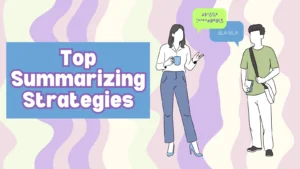Are you a student who’s ever been assigned to write a summary of a book or a film but found yourself unsure of where to start? Or perhaps you’re a teacher looking for effective ways to teach summary writing in your classroom? In either case, understanding what a plot summary is and how to write one is important. Initially, a plot summary is a concise, focused presentation of the main events and themes of a narrative, whether it’s a novel, a movie, or any other form of storytelling.

✅ AI Essay Writer ✅ AI Detector ✅ Plagchecker ✅ Paraphraser
✅ Summarizer ✅ Citation Generator
Defining a Plot Summary
A plot summary is much more than just a simple retelling of a story. It’s a carefully crafted, concise synopsis that captures the heart of a narrative. This text captures the main events, characters, and their interactions into a digestible format, which enables readers to grasp the core essence of the story without having to dive into many details. For students, a plot summary is a way to better comprehension and analysis that allows them to understand the plot, be aware of character motivations, and identify the central themes and conflicts that drive the narrative forward.
One of the key characteristics of a plot summary is its brevity. Unlike a detailed analysis or a complex retelling, a plot summary focuses only on the most necessary elements of the story. It strips away extraneous details and subplots, talking about the main arc that defines the plot. This focused approach makes plot summaries vital for:
- quick reference
- review
- as a foundation for a more detailed study.
Another defining feature of a plot summary is its neutrality. A well-crafted summary maintains an objective tone and avoids personal opinions or interpretations. It presents the facts of the story as they are and allows readers to form their judgments and analyses based on the short information given.
Plot summaries are versatile and can be applied to a wide range of narrative forms. Whether it’s the detailed storyline of a novel, the fast-paced action of a film, or the factual recounting of a non-fiction work, a plot summary serves as a universal tool for capturing the key points of any story. This adaptability makes plot summaries an great resource for students and writers alike, providing a clear overview of core elements of the story.
The Purpose of a Plot Summary
The primary purpose of a plot summary is to provide a concise overview of a story’s plot, making it easier for readers or viewers to identify the main events and themes. However, they’re also handy tools in school and even in the workspace.
In an educational setting, plot summaries help students get the gist of a story. They break down complicated tales into easy-to-digest bits, so you can grasp the main ideas. This makes it easier to dive deep into the text and understand things like themes, character growth, and the story’s arc. Plus, plot summaries are great for sharpening your analytical skills. They teach students to take a big chunk of information and boil it down to the essentials. This skill is key for analyzing literature and comes in handy in lots of different situations where clear communication is important.
Plot summaries also serve as reference tools in discussions and presentations. They provide a quick and accessible overview of a story. In turn, students and teachers get to engage in meaningful dialogue without getting bogged down in the never-ending details. It’s hard to disagree that this efficiency is particularly beneficial in classroom settings, where time is limited, and the focus is on critical thinking and discussion. And, during exams, having a plot summary in your back pocket can really help. It gives you a clear way to remember and organize the main points of a story, helping you craft solid answers that stand out.
Now, for teachers, plot summaries are basic elements for classroom activities and discussions. They serve as a starting point for exploring themes, characters, and literary devices, which helps professors and other educators to design lessons that are both engaging and informative.
Beyond the classroom, plot summaries have practical applications in various fields, such as publishing, where they are used in book jackets and marketing materials to entice potential readers. In the film and television industry, plot summaries are key components of pitches and promotional content, providing a snapshot of the storyline to capture the interest of investors.
How to Write a Great Plot Summary
Creating an engaging plot summary is a multi-step process that requires attention to detail and a good understanding of the story. Sorry, but you can’t create a good summary without reading the full text first, but there is a way to make that whole thing much easier. Here’s a breakdown of each stage, with examples to help illustrate the progress made at each step:
Prewriting
The prewriting stage is all about preparation. Begin by diving into the story, whether that means reading a book or watching a movie. As you go through the plot, take detailed notes on the main events, characters, and themes. Try to identify the key moments that define the beginning, middle, and end of the plot.
For example
If you’re summarizing “Harry Potter and the Sorcerer’s Stone”, you might note
- The beginning: Harry discovers he’s a wizard;
- The middle: His arrival and adventures at Hogwarts;
- The end: The confrontation with Voldemort.
Drafting
Once you’ve gathered your notes, it’s time to start drafting your summary. Begin with an introduction that sets the scene and introduces the main characters.
For instance
- Start your “Harry Potter” summary with, “In J.K. Rowling’s ‘Harry Potter and the Sorcerer’s Stone,’ young Harry Potter discovers his magical heritage and begins his first year at Hogwarts School of Witchcraft and Wizardry.”
- Then, proceed to summarize the plot in chronological order, focusing on the key events that move the story forward.
- Make sure to include the climax and resolution of the story, such as Harry’s confrontation with Voldemort and the securing of the Sorcerer’s Stone.
Final Draft and Polishing
The final stage is all about polishing your summary. Read through your draft and revise it for clarity and conciseness. Check that you’ve accurately captured the main ideas of the plot without including personal opinions or unnecessary details.
For example
- Revise a sentence like “Harry, who is brave and kind, defeats the evil Voldemort” to “Harry defeats Voldemort.”
- Keep the focus on the plot rather than character analysis.
Once you’re satisfied with your summary, give it a final proofread to keep it well-written and engaging.
By following these steps and using the examples as a guide, you can write a great plot summary that captures the essence of the story and engages your readers.
An Example of a Quality Plot Summary
Example 1: “On the Road” by Jack Kerouac


“On the Road” is a novel that chronicles the cross-country adventures of Sal Paradise and his friend Dean Moriarty. The story begins in New York, where Sal, an aspiring writer, meets Dean, a charismatic ex-con. Together, they embark on a journey across America, seeking freedom and experiencing the vibrant cultures of the late 1940s. Along the way, they encounter a diverse cast of characters, each adding depth to their understanding of life and themselves. The novel culminates in a poignant realization about the nature of their quest and the impermanence of their youthful aspirations.
Example 2: “Dune: Part One” (2021)

“Dune: Part One” is a sci-fi epic set in a distant future where noble houses vie for control of the desert planet Arrakis, the only source of a valuable substance called spice. The story follows Paul Atreides, a young nobleman whose family is entrusted with the stewardship of Arrakis. As political intrigue and betrayal unfold, Paul is thrust into a journey of survival and self-discovery. He must navigate the treacherous landscape of Arrakis, ally with its native Fremen, and embrace his destiny as a prophesied leader. The film ends with Paul and his mother joining the Fremen, setting the stage for the next chapter in the saga.
Conclusion
Plot summaries play a significant role in the studying process and help students to grasp the main events and themes of a story quickly. They are necessary tools for teachers, providing a foundation for classroom discussions and activities. Learning how to write a plot summary is the first step to developing reading comprehension and analytical skills. By following the steps outlined in this guide, you can learn to write effective plot summaries.
FAQ
Follow us on Reddit for more insights and updates.
Comments (1)
Welcome to A*Help comments!
We’re all about debate and discussion at A*Help.
We value the diverse opinions of users, so you may find points of view that you don’t agree with. And that’s cool. However, there are certain things we’re not OK with: attempts to manipulate our data in any way, for example, or the posting of discriminative, offensive, hateful, or disparaging material.





I can see what students are struggling with when summarising fiction stories. This document was beneficial